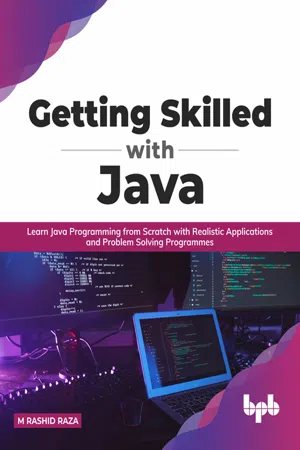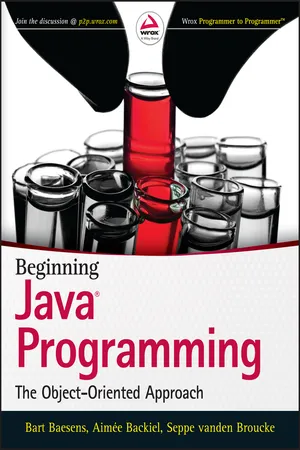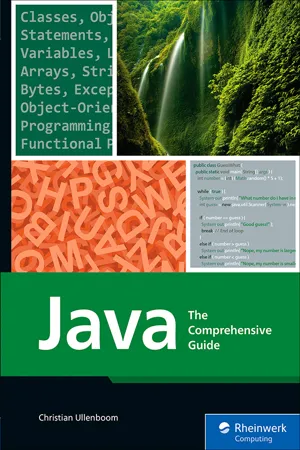Computer Science
Java Static Keywords
Java Static Keywords are used to define class-level variables and methods that can be accessed without creating an instance of the class. The static keyword can also be used to create static blocks of code that are executed when the class is loaded into memory. Static methods and variables are shared across all instances of the class.
Written by Perlego with AI-assistance
Related key terms
Related key terms
1 of 4
Related key terms
1 of 3
5 Key excerpts on "Java Static Keywords"
- eBook - ePub
Getting Skilled with Java
Learn Java Programming from Scratch with Realistic Applications and Problem Solving Programmes (English Edition)
- M Rashid Raza(Author)
- 2022(Publication Date)
- BPB Publications(Publisher)
Class variables are those variables, which are declared at the class level and all the instances of that class are going to share the same variable with the same value. If any instance updates the value of a class variable, the same will be updated for all the instances of that class. It is not a good practice to update the value of any class variable by any program. The variables that have a fixed value should be declared as class variables. We declare the class variable using a static keyword. The static keyword ensures that only one instance of this variable will be created. The class variable is also known as static variable. Below is an example of variable declaration and assignation.static int age = 5;If you don’t assign any value in a static variable and further use that variable to perform some operation in your program, then it will give you the default value of that variable based on specified default values for that data type.Example 3.4 : Default value assignation by JVMFor example: public class StaticVariable { static int age; public static void main(String[] args) { System.out.println(age); } }The preceding program will run successfully and print 0, which is the default value for int in Java.NOTE: Anything declared using static keyword gets loaded in the memory at the time the class gets loaded. Static is not dependent on object initialization. Hence, class variable is always declared as a static.Constant variable
Constant variables are those variables that are fixed and once you assign a value to it, you cannot change it. It will remain the same always. If you try to reassign or update the value of the final variable, the compiler will generate an error message for you “The final field FinalVariable.XYZ cannot be assigned - eBook - ePub
Java Professional Interview Guide
Learn About Java Interview Questions and Practise Answering About Concurrency, JDBC, Exception Handling, Spring, and Hibernate
- Mandar Maheshwar Jog(Author)
- 2021(Publication Date)
- BPB Publications(Publisher)
"Total Employees :" +Employee.getCounter());- }
- }
Can I apply static anywhere apart from variables?
Certainly, apart from the variables, you can apply the static keyword at numerous locations. You can make any method as static. You can declare the static block, which executes before the main() method. Apart from this, there is a concept called as static instantiation block, which is executed just before the creation of an object. You can also use the static keyword with a class that is termed as a static class. But, you cannot make any class as static unless it is nested in some other class. Such class is called as a static nested inner class .What is the use of this keyword?
The this keyword refers the current object. Normally, it is used to call another constructor of the same object. This is the only way to call the constructor of the same object. You can call a parameterized constructor from default or from default to a parameterized constructor using the this keyword.Also, if there is any ambiguity with the local variables and instance variables, you can use the this keyword to denote the instance variables differently than the local variable.Explain the significance of the super keyword
The super keyword refers to the super class. If you want to call the members of the super class explicitly from a subclass, then you can use this keyword. You can invoke data members or member functions of a super class. Not only that, you can also invoke the constructor of the super class explicitly from a subclass constructor.Another use of the super keyword is done by JVM when it calls the default constructor of super class implicitly from the constructor of the subclass. The super keyword must be the first line of the constructor.Why the super keyword must be located as the first line of the constructor?
When we say that we are in a subclass, it obviously contains some data members. Many times, the data members of the subclass are dependent on the data members of the super class. So, unless the data members of super classes are initialized, the subclass data members cannot be initialized. So, to make sure that the super class data members are initialized prior to any member of the subclass, the super keyword is placed as the first line of the constructor. - eBook - ePub
Beginning Java Programming
The Object-Oriented Approach
- Bart Baesens, Aimee Backiel, Seppe vanden Broucke(Authors)
- 2015(Publication Date)
- Wrox(Publisher)
). Therefore, it is a good idea either to program defensively and always check for null when retrieving an object and before moving on with using the object, or to program in such a way that only in a limited number of cases a null variable is passed from one part of your program to another.This code also immediately illustrates that you are not forced to use the default values for instance variables. For example, you can modify the Book class to assign defaults to the title and author variables:class Book { String title = "Unknown Title"; String[] authors = new String[]{"Anonymous"}; } And, combining this with the knowledge on how to define multiple variables of the same type in one go, you can add: class Book { String title = "Unknown Title"; String[] authors = new String[]{"Anonymous"}; int yearReleased = 2014, copiesSold = 0; }With this knowledge under your belt, you might be wondering, as each object keeps its own copy of instance variables, is there also a way to define a common variable, something that’s shared between all objects belonging to the same class? Indeed there is . . .Class Variables
In object-oriented programming, a class variable, also denoted as a static variable, is a variable that’s been allocated “statically”—meaning that this variable is shared between all objects (instances) belonging to this class. Further, since class variables belong to the class blueprint, it is not necessary to create objects to be able to access and modify class variables. It is sometimes argued that class variables do not really adhere to “pure” object-oriented programming principles. Other, stricter programming languages, such as Scala, do not allow them, for instance. That said, this is not to be regarded as a shortcoming of Java, as we will see that class variables can come in handy in many cases. However, it is best not to overuse them.I’ll explain this by providing an example. Let’s modify the Book - No longer available |Learn more
- Mala Gupta(Author)
- 2016(Publication Date)
- Manning Publications(Publisher)
- A static method or variable can’t access non-static variables or methods of a class. But the reverse is true: non-static variables and methods can access static variables and methods.
- static classes and interfaces are a type of nested classes and interfaces, but they aren’t covered in this exam.
- You can’t prefix the definition of a top-level class or an interface with the keyword static. A top-level class or interface is one that isn’t defined within another class or interface.
Features and components of Java:- Object orientation— Java emulates real-life object definition and behavior. It uses classes, interfaces, or enums to define all its code.
- Abstraction— Java lets you abstract objects and include only the required properties and behavior in your code.
- Encapsulation— The state or the fields of a class are protected from unwanted access and manipulation.
- Inheritance— Java enables its classes to inherit other classes and implement interfaces. The interfaces can inherit other interfaces.
- Polymorphism— Java enables instances of its classes to exhibit multiple behaviors for the same method calls.
- Type safety— In Java, you must declare a variable with its data type before you can use it.
- Automatic memory management— Java uses garbage collectors for automatic memory management. They reclaim memory from objects that are no longer in use.
- Multithreading and concurrency— Java defines classes and interfaces to enable developers to develop multithreaded code.
- Java isn’t a single-threaded language.
Passage contains an image
1.9. Sample exam questions
Q1-1. Given: class EJava { //..code } Which of the following options will compile?- package java.oca.associate; class Guru { EJava eJava = new EJava(); }
- package java.oca; import EJava; class Guru { EJava eJava; }
- package java.oca.*; import java.default.*; class Guru { EJava eJava; }
- package java.oca.associate; import default.*; class Guru { default.EJava eJava; }
- None of the above
Q1-2. The following numbered list of Java class components is not in any particular order. Select the acceptable order of their occurrence in any Java class (choose all that apply): - eBook - ePub
Java
The Comprehensive Guide
- Christian Ullenboom(Author)
- 2022(Publication Date)
- SAP PRESS(Publisher)
private in which only the object itself can use this method. This distinction is useful when methods are intended to reduce complexity and solve sub-problems. Private methods are usually not displayed in the help because they are an implementation detail.The static keyword indicates that the method can be used with the class name, that is, no instance of an object is required.Other Modifiers and Exceptions*
Many methods that have other modifiers and an extended signature. Another example from the API documentation is shown in Figure 2.11 . The visibility of this method is protected , which means that only derived classes and classes in the same directory (the same package) can use this method. An additional modifier is final , which in inheritance doesn’t allow the subclass to overwrite the method and give it new program code. Finally, the throws keyword is followed by an exception. This exception tells you something about errors that might be caused by the method and what the programmer must take care of. In connection with inheritance, we’ll discuss protected and final later. Chapter 9 is devoted to exceptions. Based on “Since: 1.1” in the documentation, we can note that the method has existed since Java 1.1. The information can also be bound to the class.Figure 2.11 Extract from the API Documentation for the java.net.ServerSocket Class2.7.3 Calling a Method
Since a method is always associated with a class or object, the owner of a method must be specified when the method is called. In the case of System.out.println() , println() is a method of the out object. If we form the maximum of two floats via the Math.max(a, b) call, then max( ... ) is a (static) method of the Math class. For the caller, who is offering this method, and who is also receiving this message, is apparent. What the caller does not see is how the method works. The method call branches to the program code, but the caller doesn’t know what happens since only the result is used.The called method is identified by its name. The parameter list is enclosed by a pair of parentheses . These parentheses must be included even if the method doesn’t contain any parameters at all. The number and types of the passed values must match the dec laration of the method. For instance, Math.max(...) requires exactly two parameters, and if the number is correct or the types are not correct, a compiler error will occur. [ 81 ]
Index pages curate the most relevant extracts from our library of academic textbooks. They’ve been created using an in-house natural language model (NLM), each adding context and meaning to key research topics.
Explore more topic indexes
Explore more topic indexes
1 of 6
Explore more topic indexes
1 of 4




